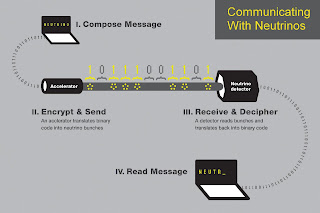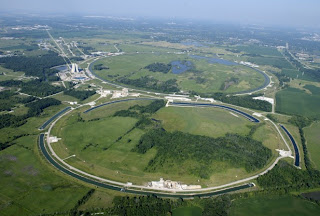According to a Wednesday article from Ars Technica reporter Casey Johnston, the scientists, who were representing the University of Rochester and North Carolina State University (NC State), fired the neutrinos through roughly 780 feet of solid bedrock. When the particles emerged on the other side, the recipients were clearly able to make out the intended message, which was quite simply the word “neutrino.”
The neutrinos were produced at the Fermi National Accelerator Lab (Fermilab) facility located near Chicago, using one of their particle accelerators to produce the high-energy beam and then the MINERVA detector, a multi-ton detector located in a cave more than 300 feet below the Earth’s surface, to read the binary code-message, Rebecca Boyle reported on Thursday.
“Their breakthrough is pretty impressive,” Boyle said. “Using neutrinos, you could theoretically communicate between any two points without any cables or wires — through water, which is what makes them an attractive option for marine applications, or even through the entire planet.”
“Chargeless and tiny, neutrinos are unperturbed by obstacles the way radio waves are,” she added.
In a March 14 press release, the University of Rochester suggested some possible uses for these neutrino messages, including long-distance communications originating from submarines or using the technology to communicate with something in outer space, even allowing the signal to travel uninterrupted through moons or planets to reach its destination.
 However, they note that the complex equipment currently required to send such a message means that everyday use of energy beams for communication is still a good ways off.
However, they note that the complex equipment currently required to send such a message means that everyday use of energy beams for communication is still a good ways off.“Of course, our current technology takes massive amounts of high-tech equipment to communicate a message using neutrinos, so this isn’t practical now,” University of Rochester physics professor Kevin McFarland, one of the experts who worked on the project, said in a statement. “But the first step toward someday using neutrinos for communication in a practical application is a demonstration using today’s technology.”
NC State Electrical and Computer Engineering Professor Dan Stancil, the lead author of a paper describing the research — which has been submitted to the journal Modern Physics Letters A — admits that neutrino-based methods of communication would be “much more complicated” than current wireless types of communications. However, he notes that the neutrino-based system would make it possible “to communicate between any two points on Earth without using satellites or cables,” which could have “important strategic uses.”
Source: redOrbit

